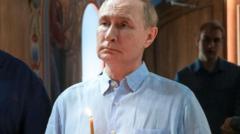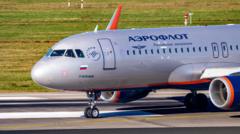This report highlights the traumatic psychological effects experienced by Ukrainian soldiers returning from frontline drone warfare. They now grapple with "droneophobia," a condition induced by the constant presence of drone sounds, leading to heightened anxiety and PTSD-like symptoms.
The Shadows of Drone Warfare: A Haunting Return for Ukrainian Soldiers

The Shadows of Drone Warfare: A Haunting Return for Ukrainian Soldiers
As drone warfare redefines the battlegrounds of Ukraine, returning soldiers face psychological scars that extend beyond the front lines.
In a cramped apartment in Kyiv, Pavlo, a 30-year-old drone operator who has recently left the Ukrainian front lines, is confronted by the lingering effects of his experiences. Zipping open a black case, which contained a four-rotor drone, he attempted to fly it indoors, but the device failed to respond. With a slight smile and words of reassurance, he said, “Sorry, not today.” However, it was his time as a pilot of first-person view (FPV) drones during combat that continues to haunt him with a persistent echo of dread.
Over the past year, FPV drones – agile and deadly with their capacity to carry explosives – have transformed the nature of warfare in Ukraine. Once considered a primary threat, heavy artillery and tanks have given way to these smaller, remote-controlled devices that seek out both armored vehicles and individual soldiers. "You are being hunted," Pavlo said, emphasizing the inescapable anxiety provoked by the drone’s unsettling buzz.
Despite his return to Kyiv, Pavlo struggles to shed the ominous presence of drones. The hum of everyday machinery—lawnmowers, motorcycles, air conditioners—invokes memories of imminent danger, triggering panic. "I don’t like going into nature anymore; I can't stand the sound," he confides. This trauma, while not novel, has grown distinct with the rise of drone warfare.
Dr. Serhii Andriichenko, a leading psychiatrist at Kyiv's military hospital, explains how “droneophobia” has emerged as a prevalent disorder among returning soldiers. Many report acute stress and anxiety linked to ordinary mechanized sounds surrounding them. With thousands of veterans now back home, Dr. Andriichenko notes a marked increase in mental health issues driven by the unique threat posed by drones.
One veteran, Savur, who lost an arm in a drone strike, recalls the FPVs as “a permanent sound,” contrasting them with traditional artillery, which is fleeting. The constant whirring of drones created a relentless psychological burden; silence in observation could spark the heart-pounding fear of a drone’s return.
The inability to escape the drone’s presence extends beyond the frontlines. For combat troops, the technological reach of drones has rendered previously safe zones vulnerable, with threats manifesting from up to 40 kilometers away. Commander Nazar Bokhii experienced horror firsthand when an FPV drone detonated nearby, resulting in the loss of both hands and his left eye. Though he has mostly reconciled with his trauma, the psychological effects of drone sounds persist.
Bokhii divulges his unit's use of drone sounds to psychologically manipulate enemy forces, revealing a chilling dynamic where sound itself becomes a weapon. The targeted institutions are beginning to interrupt the civilian populace as well. In Kherson, a city familiar with drone attacks, residents live in constant alert. With reported casualties resulting from direct strikes on civilians, fear has become a communal reality. Dmytro Olifirenko, a border guard, narrates his own encounter with a drone that targeted a bus stop, leaving him injured.
Now, for civilian populations, even commonplace sounds morph into sources of anxiety. Olifirenko, constantly haunted by the memories of his injury, describes the inescapable toll on mental health as he navigates life under the constant specter of drone warfare.
For returning soldiers like Pavlo, the psychological imprint of their experiences may never fully fade. “You see the world as a battlefield,” he reflects, revealing how everyday sounds now provoke a fight-or-flight response engrained from their severe combat experiences. The essence of danger, characterized by unknown sounds, illuminates the insidious psychological effects of warfare borne from technological advancement.
Svitlana Libet contributed to this report. Photographs by Joel Gunter.
Over the past year, FPV drones – agile and deadly with their capacity to carry explosives – have transformed the nature of warfare in Ukraine. Once considered a primary threat, heavy artillery and tanks have given way to these smaller, remote-controlled devices that seek out both armored vehicles and individual soldiers. "You are being hunted," Pavlo said, emphasizing the inescapable anxiety provoked by the drone’s unsettling buzz.
Despite his return to Kyiv, Pavlo struggles to shed the ominous presence of drones. The hum of everyday machinery—lawnmowers, motorcycles, air conditioners—invokes memories of imminent danger, triggering panic. "I don’t like going into nature anymore; I can't stand the sound," he confides. This trauma, while not novel, has grown distinct with the rise of drone warfare.
Dr. Serhii Andriichenko, a leading psychiatrist at Kyiv's military hospital, explains how “droneophobia” has emerged as a prevalent disorder among returning soldiers. Many report acute stress and anxiety linked to ordinary mechanized sounds surrounding them. With thousands of veterans now back home, Dr. Andriichenko notes a marked increase in mental health issues driven by the unique threat posed by drones.
One veteran, Savur, who lost an arm in a drone strike, recalls the FPVs as “a permanent sound,” contrasting them with traditional artillery, which is fleeting. The constant whirring of drones created a relentless psychological burden; silence in observation could spark the heart-pounding fear of a drone’s return.
The inability to escape the drone’s presence extends beyond the frontlines. For combat troops, the technological reach of drones has rendered previously safe zones vulnerable, with threats manifesting from up to 40 kilometers away. Commander Nazar Bokhii experienced horror firsthand when an FPV drone detonated nearby, resulting in the loss of both hands and his left eye. Though he has mostly reconciled with his trauma, the psychological effects of drone sounds persist.
Bokhii divulges his unit's use of drone sounds to psychologically manipulate enemy forces, revealing a chilling dynamic where sound itself becomes a weapon. The targeted institutions are beginning to interrupt the civilian populace as well. In Kherson, a city familiar with drone attacks, residents live in constant alert. With reported casualties resulting from direct strikes on civilians, fear has become a communal reality. Dmytro Olifirenko, a border guard, narrates his own encounter with a drone that targeted a bus stop, leaving him injured.
Now, for civilian populations, even commonplace sounds morph into sources of anxiety. Olifirenko, constantly haunted by the memories of his injury, describes the inescapable toll on mental health as he navigates life under the constant specter of drone warfare.
For returning soldiers like Pavlo, the psychological imprint of their experiences may never fully fade. “You see the world as a battlefield,” he reflects, revealing how everyday sounds now provoke a fight-or-flight response engrained from their severe combat experiences. The essence of danger, characterized by unknown sounds, illuminates the insidious psychological effects of warfare borne from technological advancement.
Svitlana Libet contributed to this report. Photographs by Joel Gunter.





















